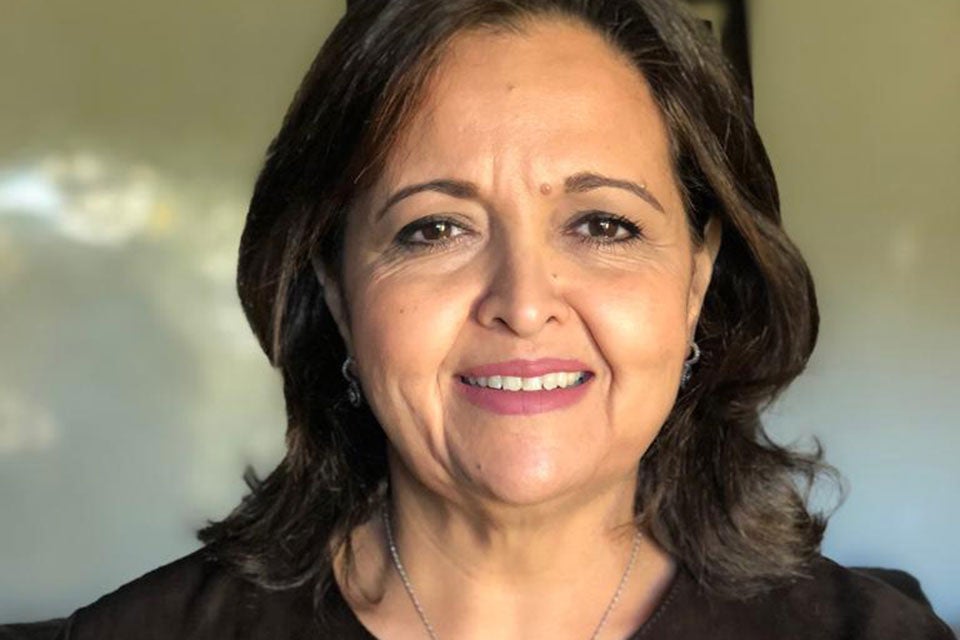Take five: Morocco’s Anti-Trafficking Law and its link to migration
Date:

Amina Oufroukhi is President of the International Judicial Cooperation Department headed by the Office of the Public Prosecutor of the Kingdom of Morocco. Prior to this, she served as a judge in the Directorate of Criminal Affairs and Pardons, Ministry of Justice, where she played a key role in drafting Morocco’s anti-trafficking law. Currently, Ms. Oufroukhi coordinates programmes to tackle trafficking between national and international institutions and Moroccan courts, includingthe continuing partnership between the Public Prosecutor’s Office and UN Women.
What was your role in drafting Morocco’s anti-trafficking law?
I organized specialized trainings for judges, police, gendarmerie and the executive branch, and produced two studies on human trafficking–the first with the International Organization for Migration (IOM) in 2009, which focused on border crossings, and the second with UN Women, which engaged 253 magistrates and 135 social workers in 2015, on ways to prevent human trafficking and protect survivors. The training sessions resulted in recommendations that led to a draft law on human trafficking, submitted to the Joint Governmental Committee. I was among the members of the drafting committee for the law adopted in 2016.
What are the law’s key provisions?
Moroccan Law No. 27.14 defines trafficking in persons for the first time and provides a clear definition of a ‘victim’ of this crime. It also highlights the responsibility of the State to identify and assist victims. Key provisions to prevent trafficking and protect women’s and girl’s rights include: detailing offenses, penalties and criminal sanctions for perpetrators; prioritizing identification of victims; providing public services for victims for protection, psychosocial care, medical assistance and free legal aid; and creating a national commission to combat and prevent human trafficking.
What are the challenges in implementing the law and how are they being addressed?
A key challenge in implementing this law in Morocco is identifying victims and encouraging them to report the crime. To overcome this, we have created a network of public prosecutors in Moroccan courts to enhance their ability to identify [the signs] and victims of human trafficking. We train them based on the latest research and follow-up mechanisms on human trafficking, and we are preparing a practical guide to help them apply the law. We also launched a large public awareness campaign in Morocoo (with documentary films, radio broadcasts, case studies and infographics) with the support of UN Women.
What is the link between trafficking, gender and migration?
According to the study conducted with UN Women, Morocco has moved from being a country of origin in the nineties to becoming more of a destination country, because it is difficult for migrants to migrate to Europe given its highly secure borders.
Among the high proportion of migrants that Morocco receives from sub-Saharan Africa in transit to Europe, [many] are often subject to smuggling … and trafficking. Moroccan women and minors are also trafficked and are forced into prostitution by intermediaries or their families, and children are [sometimes even] sold at birth. Difficulties in accessing employment and basic services, and integrating into Moroccan society, put migrants in a precarious position, resulting in exploitation and trafficking. Trafficking networks operate within these structural conditions, wherein female migrants, the most vulnerable to being trafficked, become victims and are also sexually exploited.
The Moroccan trafficking law consequently took this into account in the definition of human trafficking, and Article IV obligates the State to ensure within means available, protection, healthcare, psychosocial support for trafficking survivors, temporary accommodation, legal assistance, social integration, and the facilitation of voluntary return to countries of origin. Moreover, measures for migrant integration help to prevent trafficking.
What concrete strategies need to be implemented to prevent trafficking?
As most victims of trafficking are women and girls, including migrant women and girls, we need a new study in Morocco to consider trafficking in women and girls in relation to migration [that] analyses the stories of women and girls in the countries of origin and destination. We should also continue our training efforts to address trafficking and also look at the linkages between trafficking and migration. Moreover, we must continue to build trust between official institutions and potential or [actual] victims of human trafficking to ensure justice, thus breaking down trafficking networks. Lastly, we must continue to strengthen mechanisms of international cooperation.